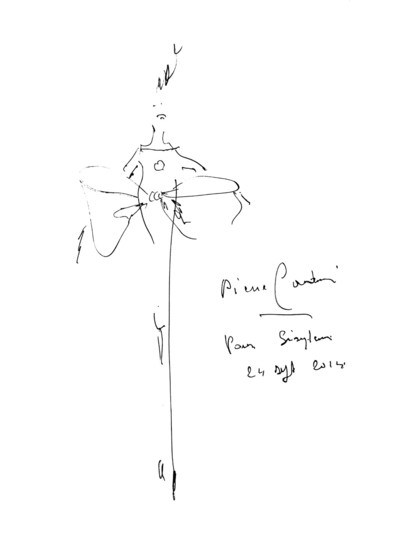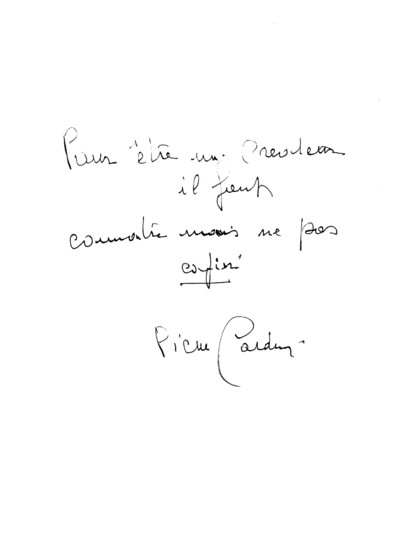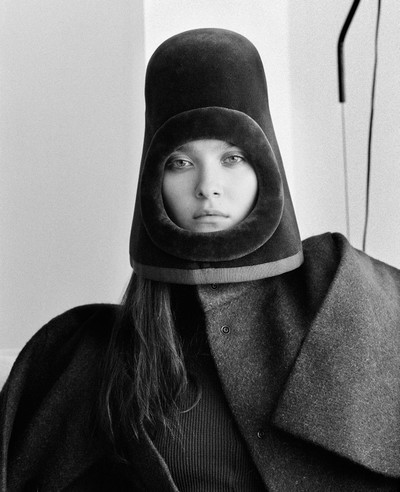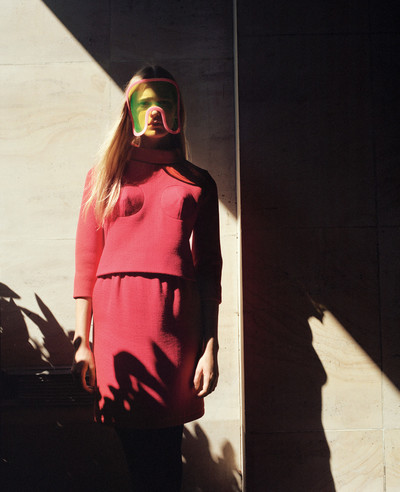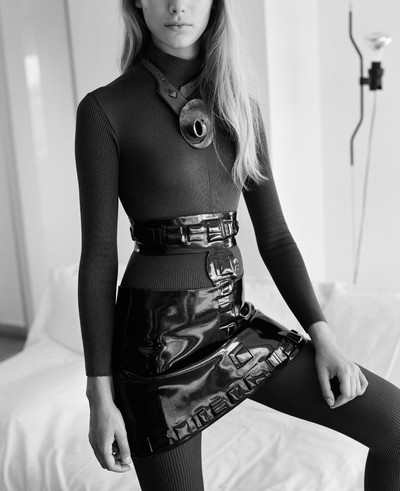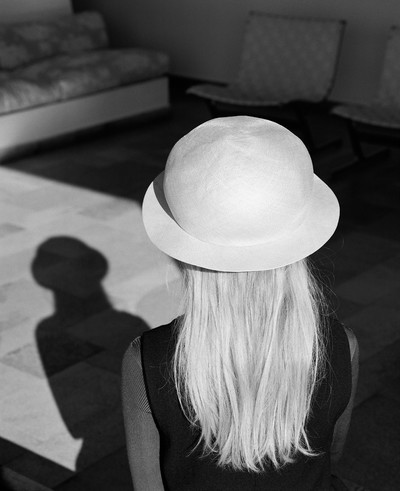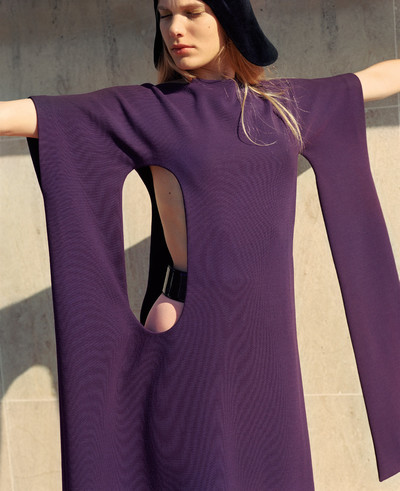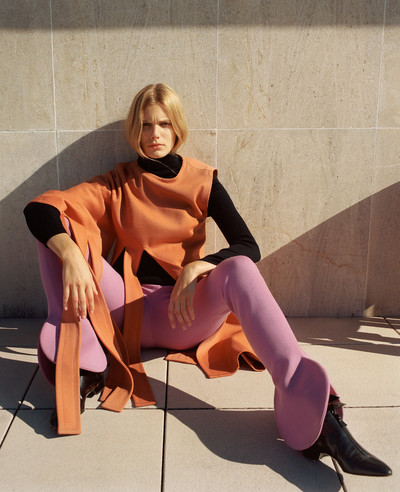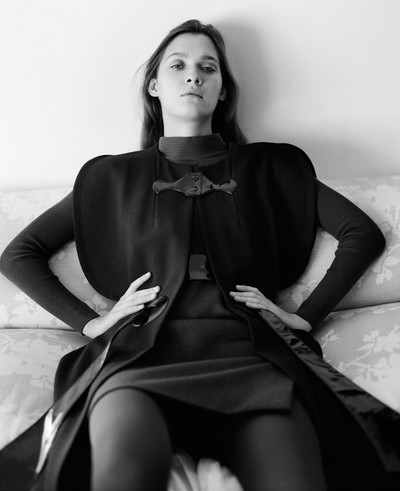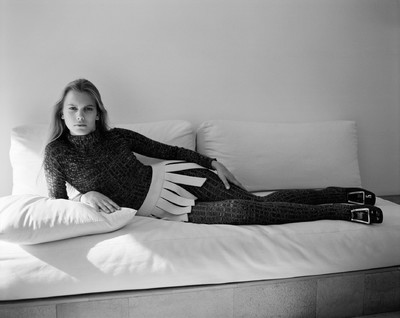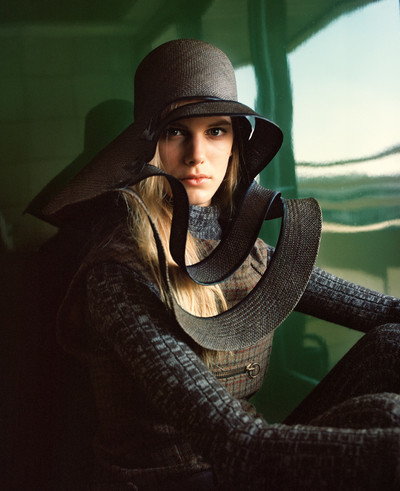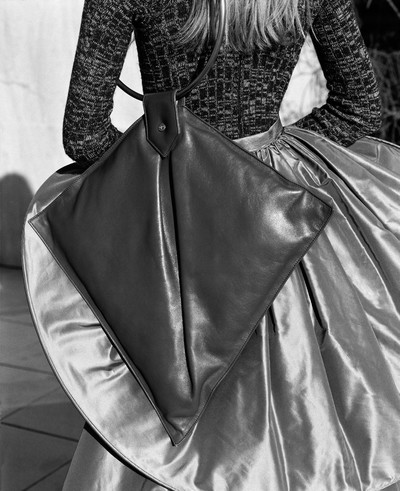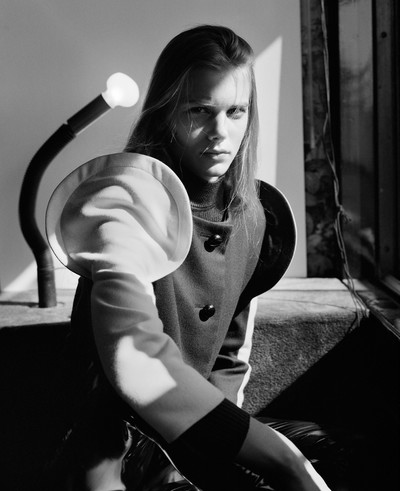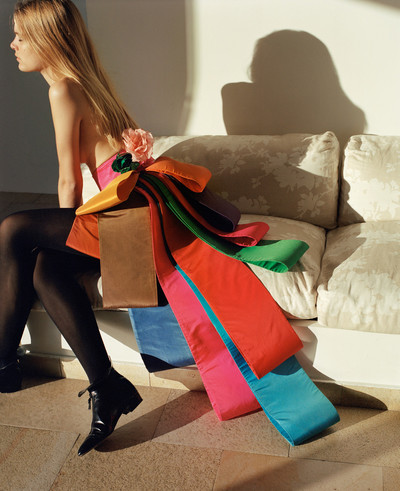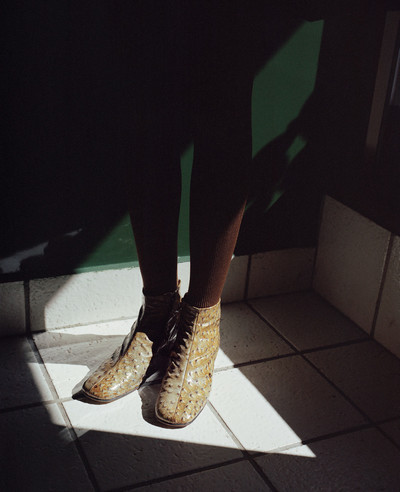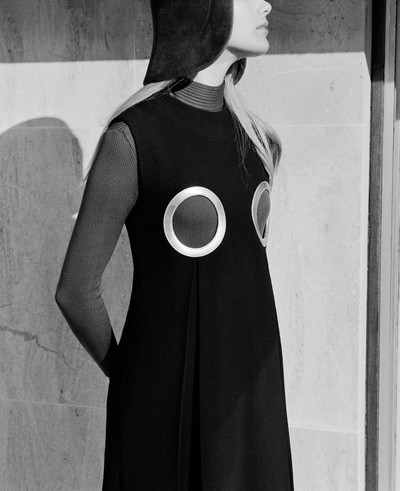Pierre Cardin gets older. His clothes stay the same age.
By Hans Ulrich Obrist
Photographs by Zoë Ghertner
Styling by Camille Bidault-Waddington
Pierre Cardin gets older. His clothes stay the same age.
Pierre Cardin, the 92-year-old French visionary and father of ready-to-wear, entered the world of haute couture under his own name in 1950, creating clothes so cutting-edge that they were described as belonging to ‘tomorrow’s world’. His list of celebrity clients included Eva Péron and Rita Hayworth. In 1959, his decision to produce a licensed prêt-à-porter collection, a defining moment in fashion history, may have shocked the establishment but it took his futuristic designs into boutiques across the world, forging him a reputation as the progenitor of branding. Influenced by his love of architecture, abstract geometric forms and technical fabrics, Cardin designed garments for a world that did not yet exist, and which remain as relevant and contemporary now, as they were avant-garde then.
Hans Ulrich Obrist: So to start with I was curious to know what you are working on at the moment?
Pierre Cardin: I’m trying to find funding for my Palais Lumière in Venice, which will effectively be the work of my life. We have the location; all that is missing is the money – the all-essential money. We’ve already been working for four years on the project.
Have you always felt Venetian?
I don’t feel Venetian, I am Venetian. I am Italian by birth, French by naturalisation.
Are you designing the Palais Lumière in partnership with an architect? Or by yourself?
With an architect, but I can’t say who it is at this stage.
Let’s talk about your other Palais, the Palais Bulles. How did that project come about?
I knew Antti Lovag because he was my neighbour in the south of France. He’d made a small bubble construction [for Pierre Bernard], which I found interesting, so we thought we’d work together in the region, and ultimately design Palais Bulles all around the world. But then Bernard died, so the project never went further than the original Palais Bulles that I financed and eventually purchased. I bought it for a few million, a lot of money at the time.
So you were also like Antti Lovag’s patron in a way.
I never trusted banks, I was my own banker. And people forget, I actually made half of the Palais Bulles myself. Antti Lovag did half, and I did the other half.
‘I’ve always drawn inspiration from the past: not because I want to copy what’s gone before, but to know what not to do in the future.’
Would you say the Palais Bulles is also a refuge for you, a place to hide away?
Yes, a monastery. With monastery corridors, but with light.
Do you ever work there?
No, I go there to relax. I used to do a lot of work there but that’s over.
And you also have the Marquis de Sade’s château?
Yes, I have the Château de Lacoste. I got it by magic. It was the patron Madame Nora Bouër who sold it to me because I knew her. I have quite a lot of residences in the south of France. I’ve had four theatres. I’ve had three boats on the Seine…
What about your relationship with architecture, because you studied architecture too…
I wanted to be an architect. Actually, I wanted to be a designer, a model, a dancer. I was very ambitious. I worked day and night. You have to be ambitious in life, otherwise you don’t succeed.
So you always worked a lot.
I’ve always worked a lot and I’ve always been passionate about research. I’ve always been to museums and archaeological sites. I’ve always drawn from the past: not to copy what’s gone before, but to know what not to do in the future.
Who were the architects that inspired you to want to become an architect yourself?
Niemeyer… with Brasilia.
And were you touched by the work of Le Corbusier?
I’m not a fan of Le Corbusier. I don’t like the housing in Marseille [the Unité d’Habitation.]
In 1945, you went to see a medium who predicted a great future for you, but at the time you wanted to become an actor.
I was working at the French Red Cross as an administrator, and as the end of the war arrived I returned to Paris to work there again. I wanted to become an actor and I had the good fortune to meet this medium. And then I met other personalities who introduced me to Jean Cocteau. I was employed by him and I did the costumes for La Belle et la Bête. That was the first money I earned, and I said to myself that by doing the costumes that would be my entrée into theatre or cinema. That was how I started in couture, via the theatre.
How was Jean Cocteau?
He was a real gentleman: he had a great education and interior noblesse. And, above all, a great talent.
So you met and worked with Cocteau, and then later you met Dior. What did you learn from him?
Elegance. I remember the first day I started at Dior. There wasn’t even an iron, so I was the one who brought one to the studio. I started doing the first collection – the ‘New Look’ with Marguerite Carré, the head of the ateliers. This was 1946. So it started with Dior: If I hadn’t been with Christian Dior, I can only imagine what would I have become – a civil servant?
So Dior freed you in a way.
Yes, absolutely.
You’ve said in interviews that right from the start you wanted to be separate from Dior; you wanted to do something very different with couture – and your ideas were based on circular forms. I’m very interested in this idea of the circle because obviously the world is round.
Yes, the circle has no end. With the square you reach the end, not with the circle. I said one day I will conquer the world: I’ve since been to New Zealand, Alaska, the top of Canada, the very bottom of Argentina, San Francisco and the islands obviously.
So you worked with Cocteau and Dior – what about Balenciaga?
No, not Balenciaga. I never worked with him, but he was very inspiring. I found him to be the most elegant and certainly the most personal of the couturiers.
Where does this idea of the future that is so present in your work come from?
There was Courrèges, Paco Rabanne and I. We did it all at the same time, within three months. Look at the modernism of it even now – it was constructing the future.
What do you regard as your main epiphany in terms of couture?
What influenced me a lot was seeing how they dressed on the moon, in 1966, 1967. That inspired me enormously. I wanted to see women in dresses that were easy to walk in; it was the practical side that interested me.
So it was based on the idea of how we might live on another planet?
At the time, it was the moon. It had to be practical: you had to be able to climb a ladder in a spaceship, unencumbered by frills, lace and other fancy things from the past.
‘Space clothing had to be practical: you had to be able to climb a ladder in a spaceship, unencumbered by frills, lace and other fancy things from the past.’
Have you always been fascinated by technology? Were you one of the first to use computers, for example?
The world of computers fascinates me very much, but it’s not of my generation. It came after me. I don’t work on a computer, I still do everything by hand. I do a hundred or so sketches a day. Everything by hand. It is personal, it’s manual.
Could you talk a little more about your experiences of space travel? Although you haven’t been into space yourself, you have worn the suit…
I couldn’t have gone at the time, but now I think there are space expeditions, but I am too old now! [Laughs] I visited NASA in the past, and I was the first civilian to put on the spacesuit worn by Buzz Aldrin.
Something that has always interested me too is your relationship between art and commerce.
It surprises people, but I love commerce: I love selling, I love buying. I bought this building, it is all mine. It’s rare. I’m not just a designer or a businessman. I’m an academic; I’m an ambassador; I’m a designer; I’m a businessman; I’m a theatre director; I’m a director; I’m a producer – no one else in the world has all those titles.
These days the idea of a ‘brand’ is totally expected, but very early on you set up international licences for your brand. What triggered this vision?
I was never interested in only designing for exclusive or rich people. l wanted to be popular – to be a designer and popular – to serve the people, with creativity.
Have you produced films?
Yes, I produced the film, Joanna Francesa starring Jeanne Moreau.
You’ve launched a lot of people’s careers.
I love launching people’s careers. Jeanne Moreau, Gérard Depardieu…
Of all these great personalities that you met, who was the one who left the greatest impression?
Mother Teresa and Mahatma Gandhi.
What struck you about them?
Their presence, their convincing magnetism just through their gaze.
You’re on great form. What is your secret?
I don’t know, I’m pretty old. I need to relax, I had a pacemaker fitted. You need to be happy to live and happy to work. I’m not a normal couturier like the others.
That is what is so fascinating. And what is the recipe to designing clothes 40 years ago that look like they were created today?
I had a vision.
They haven’t aged at all. The colours are important: do you have a favourite colour?
Green.
Why?
Blue is the sea, and green is the earth.
Other than the Palais Lumière, have you any other unrealised projects?
No, I’ve done everything. Already back then, 40 years ago, I’d already done everything in fashion. Isn’t that amazing, how modern it still looks? No one dared to do that, no one. It was provocative.
And what would your advice be to a young couturier in 2014?
To know me, but not copy me.
Models: Clarence c/o Silent Models & Emma Waldo c/o Elite Paris.
Hair: Christoph Hasenbein c/o Jedroot.
Make-up: Stephanie Kunz c/o Calliste.
Manicure: Laura Forget c/o Artlist Paris.
Photography Assistance: Corentin Thevenet & Alexandre Salle de Chou.
Styling Assistance: Marie Déhé & Marion Jolivet.
Production: Guillaume Hery at Total Management.
Special thanks to Renée Taponier & Musée Pierre Cardin.
